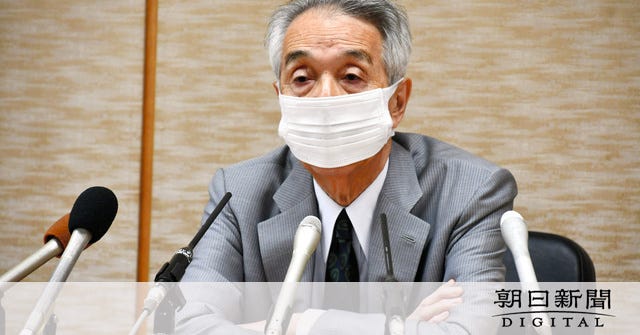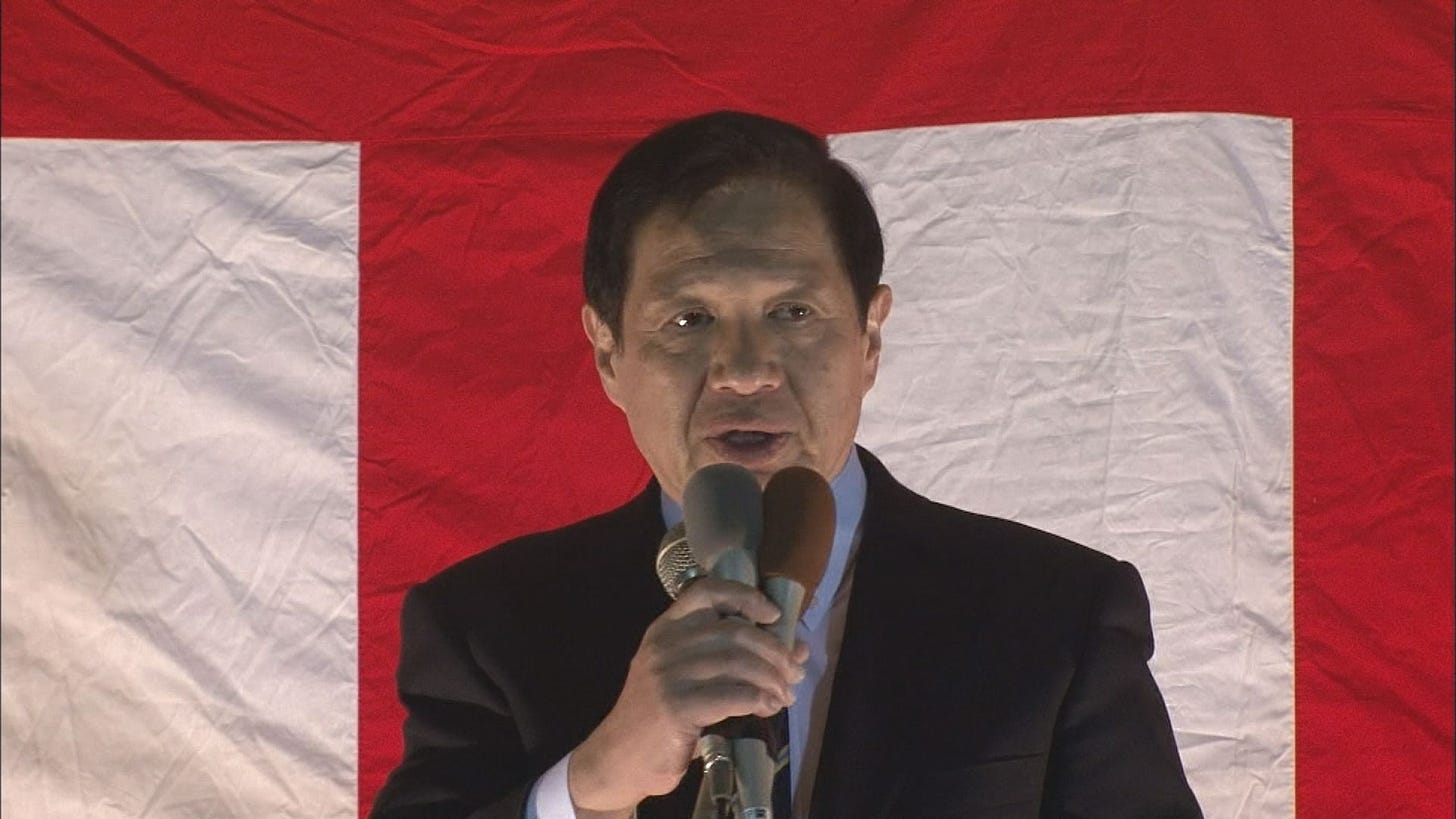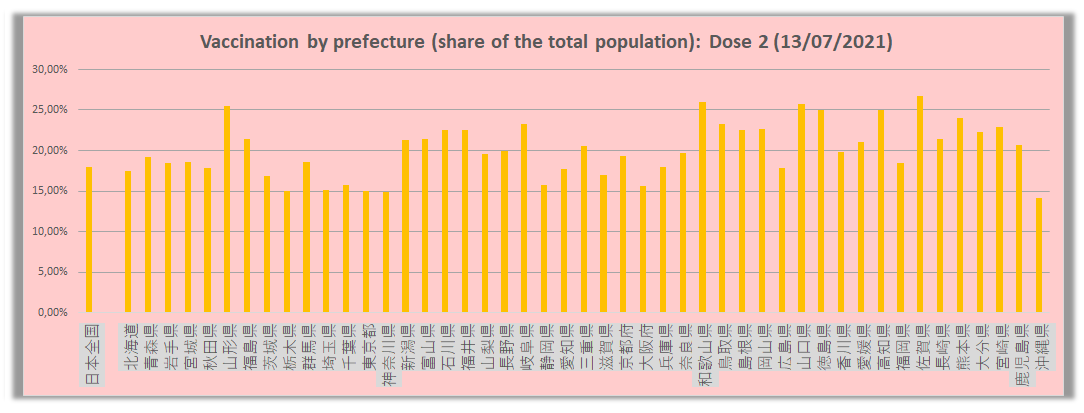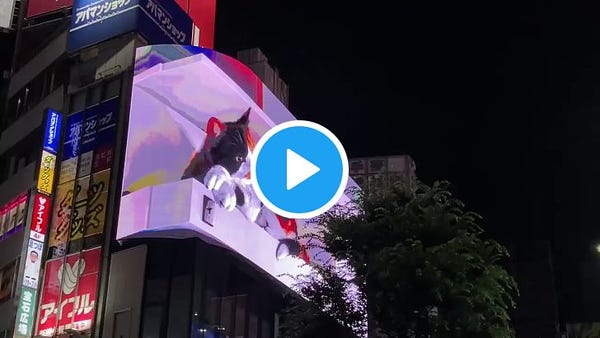With Just Months to Go, Veteran LDP Members Jump the Ship
LDP Hereditary Politics Return While the Vaccination Process Keeps Going Up
Hello everyone. Thank you for reading the NihonPolitics Newsletter. After the last two entries, where I exclusively focused on the election to Tokyo’s Metropolitan Assembly, I’m back with a regular post.
I would like to let you know that in the last weeks, too, I decided to set up a Ko-Fi account so you can help me, contributing so I can continue with my work, which takes time and a lot of effort.😊
Would you be me some Ko-fi (or Tea)? You can do it below☕🍵
If you like the work I do here on Substack and also on Twitter at @Nihonpolitics, I welcome any contribution through these two routes:
Thank you so much for your support 😊😇
I am so grateful for your help. Truthfully.
📧📧
Here you can read the previous POST I mentioned:


Now, back to normal.
Let’s go with today’s Newsletter:
Election News🗳️
The Essentials: News and weekly politics about Japan.🏆
Progress on the Vaccination Process of Japan💉
Tweet(s) of the Week💬
Election News🗳️
Last Sunday, elections took place in Nara City (Nara Prefecture) for the office of the Mayor and the city council. It was an opportunity for Ishin no Kai to expand beyond Osaka into one of its neighboring prefectures. In recent years, the party has largely been reduced to Osaka Prefecture, struggling to broaden its presence in Kansai.
This time, after the very dissipating results the party received in Tokyo, the results from Nara brought good news for Ishin no Kai!
Following the presence and election results of the party, we can situate the prefectures of the region of Kansai in several tiers:


Nara is in Tier 3 along with Kyoto and Nakayama, places where the party has struggled to penetrate since it was created almost 10 years ago.
Election for Mayor of Nara City
First elected in 2009, on Sunday Nakawaga Gen「仲川元庸」 was re-elected for a fourth term as mayor of Nara City, while running as an independent. For the first time, Ishin no Kai mounted a challenge with its own candidate, a member of the city council named Nakagawa Takashi but failed: he lost by double digits and 24k votes.
In spite of the defeat, Ishin no Kai had reason to celebrate the results for the Nara city Council election after it managing to elect all of its four candidates, with a sizable increase in the number of votes won in comparison to 2017.
The growth of the party is undeniable on the ground.
The Ishin no Kai candidates to the Assembly won 17.671 fewer votes than Takashi, the candidate for mayor, a big dropoff though. It points out the problems the party faces in winning elections outside of the parliamentary bodies. After all, wining seats in a prefectural assembly or local city council is not *that* difficult.
In the chart below, you can see the final results:
When watching the chart, one thing stands out: The lack of presence of the Constitutional Democratic Party is alarming for Japans’ second political party and the main’s opposition party. An alarming weakness despite the presence in the party of veteran politician Mabuchi Sumio「馬淵澄夫」who has represented the city of Nara in the Diet for years; in 2017 he lost for the same time the representation of Nara City in Nara District One (lost) by only 2500k votes. His local strength does not seem to have percolated to the local politics of the party.
As a lot of political watchers have pointed out, the CDPJ has a big problem in Kansai, especially in Osaka.
The Essentials: News and weekly politics about Japan.🏆
Veteran LDP Incumbents Announce Retirements in a Difficult Year
In the last weeks, several high-profile members of the Liberal Democratic Party in the Lower House of the Diet have announced their plans to retire, instead of running for reelection in the fall. Their retirement signals the growing unease within the LDP about the direction not only of Prime Minister Suga but of the party itself and its precarious position before the general election that has to take place in November, at the latest.
Between all of them, centuries of seniority will be lost, leaving seats open that could be competitive in the election. These are their names:
Ibuki Bunmei (Kyoto 1): 12 terms
Elected first in 1983, Ibuki Bunmei「伊吹文明」has been representing the District One of Kyoto since 1996. However, in spite of its record, he’s never been able to win with more than 50% of the vote what reflects the competitiveness of the District which covers central parts of the City of Kyoto. Kyoto 1 probably presents the best opportunity in the country for the Japanese Communist Party to win a Single-Member District: not only because of the nature of Kyoto, a city with a traditional leaning to the JCP but also because the party has in Kokuta Keiji a wonderful candidate. He must be one of the most successful JCP candidates in the House in the last decades.
Kokuta Keiji「穀田恵二」has been the runner up to Ibuki since 1996, even though he’s never won the district since the electoral district became an SMD (in 1993, he won after placing first in Kyoto One, when 5 seats were elected in the 中選挙区制). A veteran communist politician, on this year, the JCP could claim the seat if it's able to become the lone candidate in the race, turning it into a one-on-one fight against the future conservative candidate. Definitely it’s going to be a very exciting district to keep an eye on.
After knowing the news of his retirement, Kokuta Keiji paid homage to Ibuki, a “worthy opponent”, against whom he lost many times in the last decades. The relationship between the two was special, after knowing each other so well during the years.
Kawasaki Jiro (Proportional Block Tokai Region): 12 terms
With 12 terms on his back, Kawasaki Jiro「川崎二郎」 is a veteran LDP politician who is currently an elected member of the proportional block from the Tokai Region; he’s also represented the districts One and Two of Mie Prefecture in the past.


After announcing his retirement, the media started reporting about his eldest son who might become his succession. Japanese hereditary politics. He won’t be the only one.
Takeshita Wataru (Shimane 2): 8 terms
Located in the western half of Shimane Prefecture, Takeshita Wataru「竹下亘」 has been representing since 2000 the District 2 of Shimane, one of the most conservative parts of the country.
In 2000, Takeshita Noboru succeeded his brother and former Prime Minister Takeshita Noboru「竹下登」, who lead Japan from 1987 to 1989. Since then, this part of Shimane has become known as the “Takeshita Kingdom”, reflecting the strength of the LDP and party conservatives in this rural stronghold of western Japan. With exception of 2005 (the election of the privatization of the Postal Reform proposed by PM Koizumi) and 2009 (DPJ wave), Takeshita Wataru has always been reelected by an overwhelming margin, with more than 50% of the vote. In fact, in the last two elections, he won 69% & 67% of the vote,
The retirement of Takeshita is a blow to the LDP. Not because the district might be competitive in the fall, but because it leaves a hole in the internal architecture of the party. Since 2018 Wataru had been the chairman of the Takeshita Faction (the Heisei-Kai - 平成会), the LDP’s third-largest 会派. In the last few days, the group has expressed that they will choose a new leader after the election.
By the way, health reasons probably played a role in his decision to retire: he fighting a cancer first detected in 2019.
Miyakoshi Mitsuhiro (Toyama 2): 8
Miyakoshi Mitsuhiro「宮腰光寛」was first elected to the House in 1998 in a Special Election. Since then, Miyakoshi has been easily reflected for eight times to represent the District 2 of Toyama, in the mountainous eastern part of the prefecture.
After all these years, in the last months, there were voices asking for his retirement, with several local LDP members jockeying to become his successors.
Furthermore, in late 2020, Miyakoshi was involved in an unfortunate incident that undermined, even more, his position, making a new run untenable.


Shiozaki Yasuhisa (Ehime 1): 8 terms
In 1995, Shiozaki Yasuhisa「塩崎恭久」became a member of the House of Councillors representing Ehime Prefecture; afterward, he became the representative of Ehime’s District 1, a post he’s maintained since 2000.
During the last 20 years, Shiozaki has comfortably gotten reelected in the District One of Ehime covers the city of Matsuyama, the prefecure’s capital. Arguably, he only had a competitive race in 2009, when he survived the DPJ wave by a few thousand votes. In 2017, the last election to the House, he won with 64% of the vote.
An institutional member of the LDP, he’s an accomplished politician with significant assignments in the Japanese government throughout the years:


As Mr. Harris remembers, Shiozaki was the Chief Cabinet Secretary during Shinzo Abe’s first, and failed stint, as Prime Minister of Japan.

According to the Japanese Media, his elder son is likely to succeed him as the LDP candidate in the fall.
Okonogi Hachirou (Kanagawa 3): 8
After eight terms representing two wards of the city of Yokohama in the Lower Hosue of the Diet, in recent weeks Okonogi Hahcirou「小此木八郎」 announced his retirement in order to run for Mayor of Yokohama, one of the marquee races of the summer in Japan. Since 2000, Okonogi has presented Kanagawa’s District 3 (except in 2009 when he lost) winning around 50% of the vote in the last two elections. Located on the easter edge of Yokohama city, bordering with Kawasaki’s southern industrial areas, the district might be competitive in the fall if the LDP finds itself in a precarious position nationally.
Okonogi surprised Japan’s political world last month when he announced his retirement from the district and also from a post he held since 2020 for the second time after 2017, as the chairman of the country’s National Public Safety Commission「国家公安委員会」an external bureau to the cabinet that controls and manages the Japanese Police. Furthermore, political watchers were also surprised by his public position against the proposed “Integrated Resort projects in Yokohama”「統合型リゾート(IR)」which included a casino in the city:
It was a big surprise to see an entrenched LDP incumbent come out against a proposal that became central in the Abe years and currently enjoys the support of the incumbent Mayor of Yokohama.
The project has attracted widespread opposition, mainly from citizen and Opposition groups. His opposition to the plan, which is supported by the LDP, led the party not to endorse him for the election of Mayor in August, a race in Prime Minster Suga’s backyard because he represents the neighboring District Two of Kanagawa in the Diet (besides being PM). The key is to what extent he will articulate himself as the Anti-casino candidate, given that the opposition parties are looking for a unified candidate to run with that flag: The CDPJ has already put forward a candidate named Nakayama Takeharu「山中竹春」a Yokohama University data scientist.
Yamaguchi Taimei (Saitama 10): 7 terms
In recent days, Yamaguchi Taimei「山口泰明」 one of the top LDP politicians announced his retirement from Saitama’s District Ten, a constituency that will likely be competitive in the fall. First elected in 1996, Yamaguchi Taimei is the current Chairman of the Election Strategy Committee 「自由民主党選挙対策委員長」of the Liberal Democratic Party and he was one of the first party elders to come before the press two weeks ago, in the election night to receive the blowback from the results of the Tokyo Assembly Election.
In the last two elections, Yamaguchi was elected with only 47% of the vote, against a divided opposition. Saitama, as an urban prefecture bordering Tokyo, has a lot of districts where the Opposition and the CDPJ could make a dent in the next election. Yamaguchi’s 10 is one of them.
Some media reports his son might succeed him…
Mitsuya Norio (Mie 4): 6 terms
With just a few months to go before the election, Mitsuya Norio might not be the last LDP veteran to declare their retirement from the Lower House. Miatsuya Norio「三ツ矢憲生」was first elected in 2003 and currently represents Mie Prefecure’’s District 4, which covers the famed Ise Shrine.
In the last election, he won with 54% of the vote. The competitiveness of this district will depend on the candidates and the final turnout. According to Japanese reports, the LDP might be considering accepting the current 3-term Governor of Mie Suzuki Eikei「鈴木英敬」as a possible candidate in Mie District 4 to succeed him.
As you might have noticed, the age of all the members that have announced their retirement is close to 70. In fact, the age of the LDP party members has been a central topic of discussion among them. Presently, there’s an age limit of “73 years” for becoming an LDP candidate. The leadership of the party has been cautious in discarding the rule in spite of the pressure put on by the youngest members of the LDP, which seek to go up the party ladder. Instead, hereditary politics are back with force in the LDP (if they ever went away).
These retirements are leaving a significant hole in the ranks of the LDP in the Lower House, part of which might be filled by Opposition candidates in the fall. We cannot underestimate the importance of all these LDP members that have announced their retirement. They are some of the most experienced and relevant members of the party; they are not backbenchers.
Proposed anti-Covid Measure Burns Minister Nishimura
Last week, Nishimura Yasutoshi, the current Minister of Economic Revitalisation as well as the Covid Czar, found himself in deep, deep trouble once the public knew a new proposal his ministry and the government as a whole were working on. The mounting pressure in the last hours forced the government to backtrack and discard the following proposal.
This idea is based on two different parallel proposals against those restaurants that do not obey the “government’s request to stop serving alcohol after certain hours,” a doubtful measure that has become central and of widespread use in the Japanese Government’s tackling of the COVID pandemic:
One would entail requesting alcohol distributors to stop dealing with businesses & restaurants that do not comply with the order to stop selling booze.
The other one would have put banks and financial institutions on the line to pressure restaurants to comply.
In the last days, Nishimura had to, for two times, publicly retract from these proposals, which according to the Toyo Shinbun reports, had been a full-fledged government proposal. In fact, the Cabinet Secretariat had already started working on the inter-ministerial process, asking for cooperation from the different ministries like METI, and even external bodies like banks or the Final Services Agency. In spite of these reports, the government of PM Suga and the Kantei have tried to put the blame solely on Minister Nishimura, making him responsible for what they argue was not a “concrete proposal” but a mere discussion…
To this day, it still surprises me that neither Nishimura himself has resigned nor PM Suga has fired him. The blowback was immense, not only from the Opposition parties, always ready to criticize the government’s handling of the pandemic but from restaurateurs and small business owners, affected themselves, a part of the Japanese society that has always been thought to form part of the LDP base.
Nishimura feels the ladder below him was removed. In Spanish, we have a very beautiful saying related to this, which puts the emphasis not on having the ladder below removed but on “being left hanging from the paintbrush ” = “Se quedó colgando de la brocha”.
Can he survive in the government? A new wave of COVID appears to be coming…😒
Progress on the Vaccination Process of Japan💉
The vaccination process in Japan keeps advancing. Slowly, Japan is reaching good shares of the population at least partially vaccinated. I expect 50% of the population to get dose one by the end of August if the current pace continues.
Currently:
31.6% of the Japanese population has Dose 1 (40,156,708)
19.7% of the Japnese popualtion is compltey vaccinated (25,023,470)
These numbers con considerably grow among the senior population:
79.3% is partially vaccinated (28,134,893)
52.2% is fully vaccinated (18,537,353)
These are very good numbers that will start to bear fruit in the coming weeks!
All thanks to the VACCINES💉💉
During the last months, Japan has inoculated more than 1 million shots every day, with a record of 1.339.235 vaccines the 25th of June.
Despite several reports about the lack of vaccines or their mismatched distribution, we still cannot see a sizable reduction in the number of doses administered in Japan. We are at 1 million a day but in the next weeks, we could see such a predicted decline though, as much local administration stops the number of first doses.
Until now, in fact, Japan has managed to administer more than 4 million first doses for the last 7 weeks. 💉👏 The second doses were steadily growing until reaching almost a 50/50 proportion in the last weeks.
In the last four weeks, Japan has administered 8 million doses per week, with a record of 8.894.216 in the last week of June.
The rate of daily doses by 100 people appears to be falling in Japan though. The week-on-week changes are small.
Now we can look at the regional differences in the vaccination process:
Nationwide over 30% of the Japanese have received one dose; the number rises to 77% among seniors.
Some rural prefectures of Japan already enjoy an important share of their population at least partially vaccinated:
Yamaguchi 39.9%
Wakayama & Akita 39%
Saga 38.4%
However, other prefectures of urban nature are further behind in the administration of first odes. For instance, Tokyo is at 25.7%, Saitama at 26%, Fukuoka at 30% and Okinawa is in the last place with only 24% partially vaccinated.
Nationally, only around 20% of the Japanese are completely vaccinated; more than 50% though among seniors. In second doses, the trends observed above are maintained, with rural prefectures achieving higher rates of complete vaccination in comparison to urban Japan:
Saga 26.7%
Wakayama 26%
Yamagata 25.4%
Kochi 25%
Once again, Okinawa is dead last with only 14% of its population fully vaccinated. I guess being formed by a lot of islands makes it difficult for both the distribution and administration of does in spite of the rate of seniors living there.
Tweet(s) of the Week💬
Amazing map



I’m ready to see Shinjuku’s cat!
Thank you for reading this week’s newsletter. I hope it was helpful to you.
Follow me on Twitter at @NihonPolitics. This week I’m covering the race for Governor of Hyogo! The full results, in next week’s post:


See you next week!
If you like the work I do here on Substack and also on Twitter at @Nihonpolitics, I welcome any contribution through these two routes:
Thank you so much for your support 😊😇
























